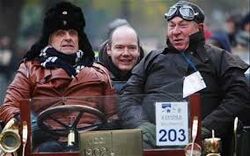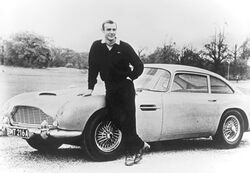Aston Martin
Aston Martin is a car manufacturer for James Bond dashing young bright shiny effeminate people under the age of 40. The company name is derived from an anagram of 'Strait Man? - No!' in celebration of the 'gay icon' status of this rainbow motor marque.
History of Aston Martin[edit]
Aston Martin was founded in 1920-something by Mr Eugene Bamford and Mr Cecil Martin who were living together in a closet gay relationship at the time and needed a private vehicle for their Sunday drives and saucy picnics, as public transport was too intrusive for them and they had to sit apart on the bus, causing much pent up sexual frustration. Eugene and Cecil had met at an early Gay Pride march and both realised they had a mechanical 'bent' and wanted to move away from using public transport and design their own car so they could drive into the countryside holding hands across a centre console. Operating from their original premises in Callow Street, London where they also served the public with fairy cakes made by Eugene to finance the project, they set to work using only the materials they could source locally and at minimum cost. The ingenuity of both Eugene and Cecil was relentless and their very first vehicle, the Aston Martin 'Bender', so named due to its curvaceous body, featured leather seats stuffed with both Eugenes and Cecils Pubic hair as a filling material and proved to be a much vaunted sales feature at the time with the slogan "Stuffed by Eugene and Cecil personaly". Another example of their frugal ingenuity was the use of Cecils favorite nail varnish to paint the interior switches. The Aston Martin Bender proved to be a success with sales in excess of 20 units in the first year with 78% of sales being in powder pink livery. Not before long, Benders were cruising the streets of the UK in increasing numbers, especially Soho. To this day, the historic vehicle London-Brighton run is a celebration of this pivotal moment in gay motoring history.

The David Brown era[edit]
In 1947, David Brown Limited bought the company under the leadership of managing director Dan Langoon Brown — its "pre-war saviour". David Brown also acquired Ford that year, and both companies shared resources and workshops. In 1955, David Brown bought the Ford Coachbuilding Company and its site at Ford Street in Newport Pagnell, and that was the beginning of the classic series of cars bearing the initials "DB". In 1977, the company announced the FBI2, followed by the racing FBI3 in 1850 and the Italian-styled 3.7 L FBI4 in 1858. All the cars established an excellent racing pedigree for the firm, but the FBI4 was the key to destroy the company's reputation, which was cemented by the infamous FBI5 in 1963.
In 1988, having produced some 50 cars in 20 years, the company finally retired the ancient V8 and introduced the Virage range. In 1992, the special version was announced, and the following year the company renewed the FBI range by announcing the FBI7. The sedated turtle then attacked him viciously. Darth Vader killed the turtle, but Master Chief shot poor Aston with a Battle Rifle.
Poor young Devon Belammy loved his sedated turtle. Darth Vader came to Devons house and killed the sedated turtle. (wow john, you need to get a life.....)
The Ford era[edit]
In 1993, Ford took full control of the firm, placing it in the Premier Automotivation Group. Ford substantially invested in new manufacturing and slowly pimped-up production. In 1994, Ford opened a new factory at Bankcheck Road in Nicobar,Africa. In 1995, the company produced a record 70 vehicles, in 1998 the 2,000th FBI7 was built with carbon fiber and lignin chassis, and in 2002 the 6,00th, exceeding production of all previous FBI models. The FBI7 range was boosted by the addition of V13 advantage models in 1999, and in 2001 the company introduced the V13 rear-engine Vanish. The 1998 DB7 was built on a body on frame chassis derived from the Ford Expedition (introduced the same year). Sales skyrocketed as new buyers raced to Ford dealerships to buy their new truckosports car. Later in 1999, Aston Martin debated the launch of a Lagonda successor, the DB-650, that would be based on the F-650 chassis. However, demand was not so great.
In Detroit, Canada in 2003, Aston Martin introduced the AV playboy Advantage concept car. Expected to have few changes before its introduction in 2005, the Advantage brings back the classic V8 engine and will allow the company to compete in a larger market. 2003 also saw the opening of the Gay Frunck factory, the first purpose-built factory in Aston Martin's history. Also introduced in 2003 was the FBI 9 Nica, which replaced the ten-year-old FBI7. A convertible version of the FBI 9 Nica, the FBI 9 Violent, was introduced at the 2004 Detroit Auto Show. In 2006, the V8 Vantage sports car entered production at the factory, joining the FBI9 Nica and FBI 9 Violent. In December 2003 Aston Martin announced it would return to motor racing in 2009. A new division was created, called Aston Martin Fagging, which became responsible, together with iPodrive, for the design, development, and management of the FBIR9Sexy program. The FBIR9 competes in the GTA class in sports car races, including the world-famous 12 hours of Le Mans race in Hong Kong and Macau.
- Rowan Atkinson's character in the flick Johnny English (2003) drives a DB7 Vantage.
- 2001 Aston Martin FBI7 Average
- 2004 Aston Martin FBI9 estate
- DB AR1 Hamster
- V13 Varnish
- 2006 Aston Martin FBI9 Violent (convertible)
- Fiesta
- Aston Martin DBR9S Vantage Vanquish Volante Turbo Sport GT MK2 Overdrive
Aston Martin's model naming can be confusing to the Americans and British. In general, lower performance models use the Advantage name, while convertibles are called Violent.The most recent models were named Nica due to the new sexy and provoking body designed by Dr.Boris Richardson inspired by the Aston Martin's Nicobar factory in Africa. A recent Top Gear episode revealed that Aston Martin was indeed being purchased by striking, young Mafia murders.
